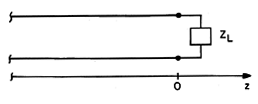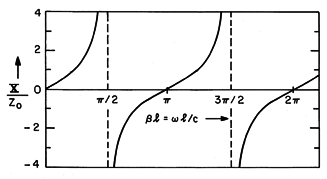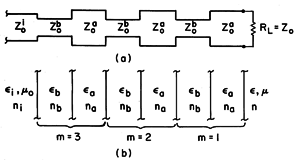The method used in Sec. 14.4 is equally applicable to finding the response to a sinusoidal excitation of an ideal transmission line. Rather than exciting the line by a voltage step or a voltage pulse, as in the examples of Sec. 14.4, the source may produce a sinusoidal excitation. In that case, there is a part of the response that is in the sinusoidal steady state and a part that accounts for the initial conditions and the transient associated with turning on the source. Provided that the boundary conditions are (like the transmission line equations) linear, we can express the response as a superposition of these two parts.

Here, Vs is the sinusoidal steady state response, determined without regard for the initial conditions but satisfying the boundary conditions. Added to this to make the total solution satisfy the initial conditions is Vt. This transient solution is defined to satisfy the boundary conditions with the drive equal to zero and to make the total solution satisfy the initial conditions. If we were interested in it, this transient solution could be found using the methods of the previous section. In an actual physical situation, this part of the solution is usually dissipated in the resistances of the terminations and the line itself. Then the sinusoidal steady state prevails. In this and the next section, we focus on this part of the solution.
With the understanding that the boundary conditions, like those
describing the transmission line, are linear differential equations
with constant coefficients, the response will be sinusoidal and at
the same frequency,  , as the drive. Thus, we assume at the
outset that
, as the drive. Thus, we assume at the
outset that

Substitution of these expressions into the transmission line equations, (14.1.4)-(14.1.5), shows that the z dependence is governed by the ordinary differential equations


Again because of the constant coefficients, these linear equations have two solutions, each having the form exp (-jkz). Substitution shows that

where 


 LC. In terms of the same two
arbitrary complex coefficients, it also follows from substitution of
this expression into (14.1.5) that
LC. In terms of the same two
arbitrary complex coefficients, it also follows from substitution of
this expression into (14.1.5) that

where Zo =  L/C.
L/C.
What we have found are solutions having the same traveling wave forms as identified in Sec. 14.3, (14.3.9)-(14.3.10). This can be seen by using (2) to recover the time dependence and writing these two expressions as


The velocity of the waves is 
 /
/ = 1/
= 1/ LC.
Because the coefficients
LC.
Because the coefficients 
 are complex, they represent
both the amplitude and phase of these traveling waves. Thus, the
solutions could be sinusoids, cosinusoids, or any combination of these
having the given arguments. In working with standing waves in Sec.
13.2, we demonstrated how the coefficients could be adjusted to
satisfy simple boundary conditions. Here we introduce a point of
view that is convenient in dealing with complicated terminations.
are complex, they represent
both the amplitude and phase of these traveling waves. Thus, the
solutions could be sinusoids, cosinusoids, or any combination of these
having the given arguments. In working with standing waves in Sec.
13.2, we demonstrated how the coefficients could be adjusted to
satisfy simple boundary conditions. Here we introduce a point of
view that is convenient in dealing with complicated terminations.
Transmission Line Impedance
The transmission line shown in Fig. 14.5.1 is terminated in a load impedance ZL. By definition, ZL is the complex number


In general, it could represent any linear system composed of
resistors, inductors, and capacitors. The complex amplitudes 
 are determined by this and another boundary condition. This
second condition represents the termination of the line somewhere to
the left in Fig. 14.5.1.
are determined by this and another boundary condition. This
second condition represents the termination of the line somewhere to
the left in Fig. 14.5.1.
At any location on the line, the impedance is found by taking the ratio of (5) and (6).

Here,  L is the reflection coefficient of the load.
L is the reflection coefficient of the load.

Thus,  L is simply the ratio of the complex amplitudes of the
traveling wave components.
L is simply the ratio of the complex amplitudes of the
traveling wave components.
At the location z = 0, where the line is connected to the load and (9) applies, this expression becomes

The boundary condition, expressed by (12), is sufficient to determine the reflection coefficient. That is, from (12) it follows that

Given the load impedance,  L follows from this
expression. The line impedance at a location z to the left then
follows from the use of this expression to evaluate (10).
L follows from this
expression. The line impedance at a location z to the left then
follows from the use of this expression to evaluate (10).
The following examples lead to important implications of (11) while indicating the usefulness of the impedance point of view.
Example 14.5.1. Impedance Matching
Given an incident wave V+, how can we eliminate the reflected wave represented by V-? By definition, there is no reflected wave if the reflection coefficient, (11), is zero. It follows from (13) that
Note that Zo is real, which means that the matched load is equivalent to a resistance, RL = Zo. Thus, our finding is consistent with that of Sec. 14.4, where we found that such a termination would eliminate the reflected wave, sinusoidal steady state or not.
It follows from (10) that the line has the same impedance, Zo, at any location z, when terminated in its characteristic impedance. Because V-=0, it follows from (7) that the voltage takes the form
The voltage has the distribution in space and time of a sinusoid traveling in the z direction with the velocity 1/
LC. At any given location, the voltage is sinusoidal in time at the (angular) frequency
. The amplitude is the same, regardless of z.
6 By contrast with Demonstration 13.1.1, where the light emitted by the fluorescent tube indicated that the electric field peaked at some locations and nulled at others, the distribution of light for a matched line would be "flat."
The previous example illustrated that at any location, a transmission line terminated in a resistance equal to its characteristic impedance has an impedance which is also resistive and equal to Zo. The next example illustrates what happens in the opposite extreme, where the termination dissipates no energy and the response is a pure standing wave rather than the pure traveling wave of the matched line.
Example 14.5.2. Short Circuit Impedance and Standing Waves
With a short circuit at z = 0, (5) makes it clear that V- = -V+. Thus, the reflection coefficient defined by (11) is
L = -1. We come to the same conclusion from the evaluation of (13).
The impedance at some location z then follows from (10) as
In view of the definition of
,
and so we can think of
l as being proportional either to the frequency or to the length of the line measured in wavelengths
. The impedance of the line is a reactance X having the dependence on either of these quantities shown in Fig. 14.5.2.
Fig 14.5.2 Reactance as a function of normalized frequency for a shorted line. At low frequencies (or for a length that is short compared to a quarter-wavelength), X is positive and proportional to
. As should be expected from either Chap. 8 or Example 13.1.1, the reactance is that of an inductor.
As the frequency is raised to the point where the line is a quarter-wavelength long, the impedance is infinite. A shorted quarter-wavelength line has the impedance of an open circuit! As the frequency is raised still further, the reactance becomes capacitive, decreasing with increasing frequency until the half-wavelength line exhibits the impedance of the termination, a short. That the impedance repeats itself as the line is increased in length by a half-wavelength is evident from Fig. 14.5.2.
We consider next an example that illustrates one of many methods for matching a load resistance RL to a line having a characteristic impedance not equal to RL.
Example 14.5.3. Quarter-Wave Matching Section
A quarter-wavelength line, as shown in Fig. 14.5.3, has the useful property of converting a normalized load impedance ZL/Zo to a normalized impedance that is the reciprocal of that impedance, Zo/ZL. To see this, we evaluate the impedance, (10), a quarter-wavelength from the load, where
z = -
/2, and then use (12).
Fig 14.5.3 A quarter-wave matching section. Thus, if we wanted to match a line having the characteristic impedance Zao to a load resistance ZL = RL, we could interpose a quarter-wavelength section of line having as its characteristic impedance a Zo that is the geometric mean of the load resistance and the characteristic impedance of the line to be matched.
The idea of using quarter-wavelength sections to achieve matching will be continued in the next example.
The transmission line model is equally well applicable to
electromagnetic plane waves. The equivalence was pointed out in Sec.
14.1. When these waves are optical, the permeability of common
materials remains  o, and the polarizability is described by
the index of refraction, n, defined such that
o, and the polarizability is described by
the index of refraction, n, defined such that

Thus, n2  o takes the place of the dielectric constant,
o takes the place of the dielectric constant,  .
The appropriate value of n2
.
The appropriate value of n2  o is likely to be very different
from the value of
o is likely to be very different
from the value of  used for the same material at low
frequencies.
used for the same material at low
frequencies.




















